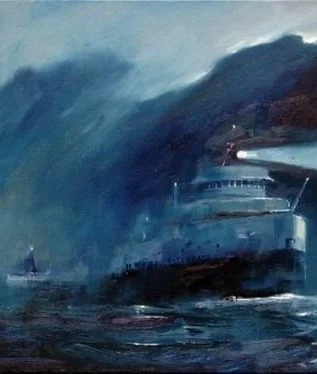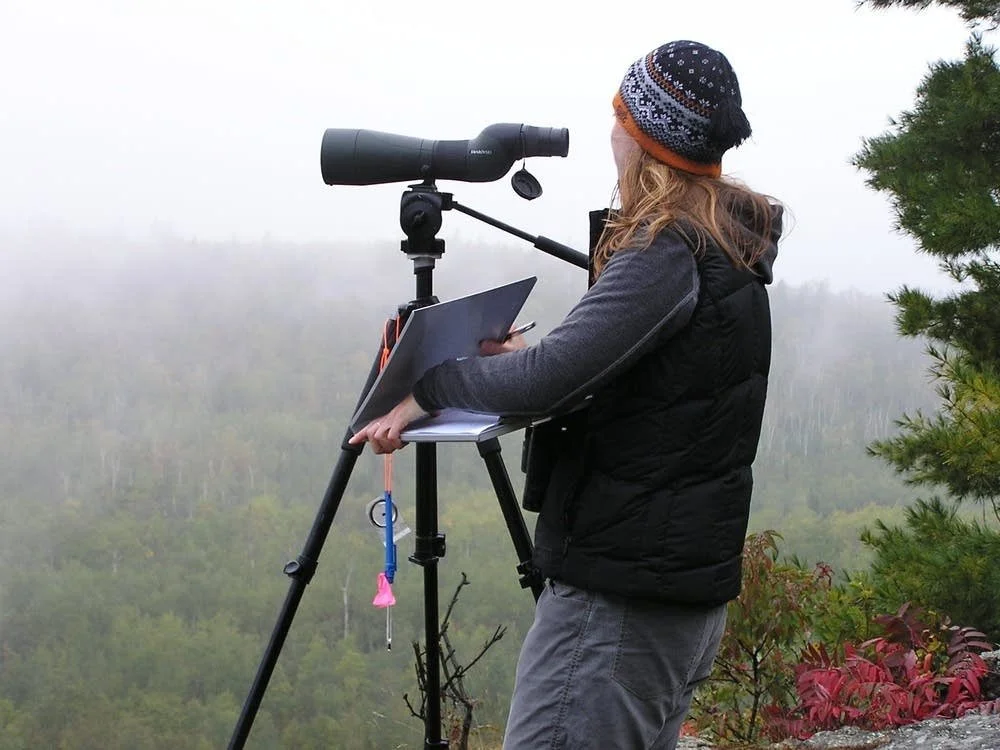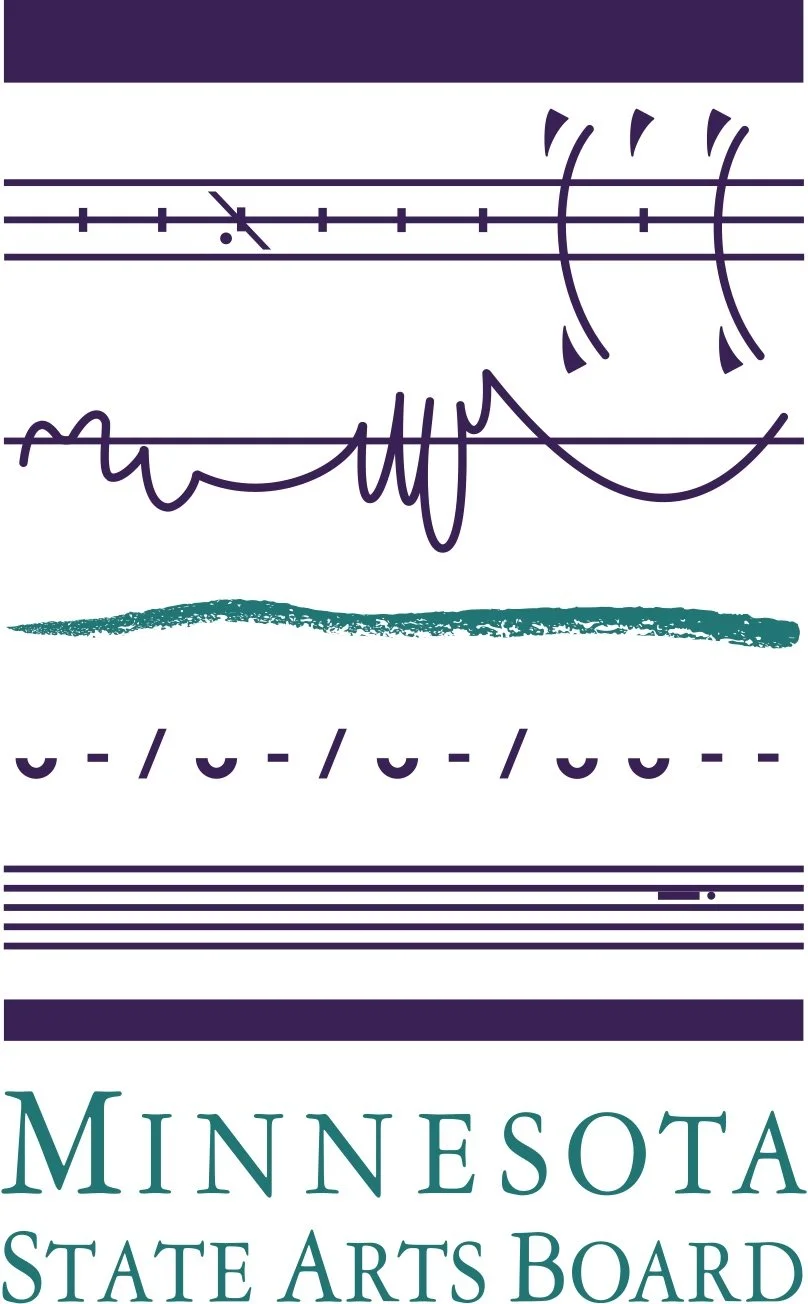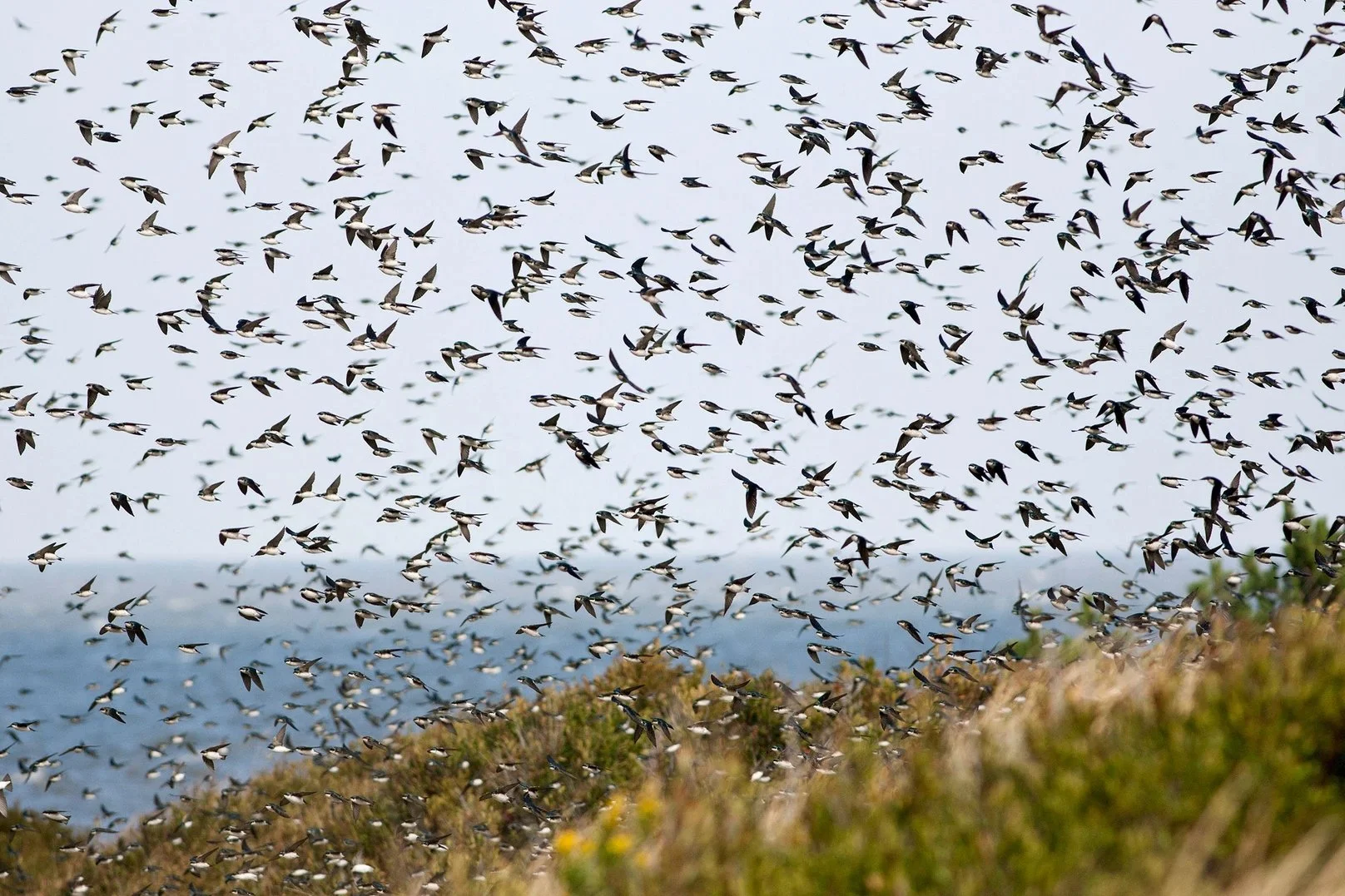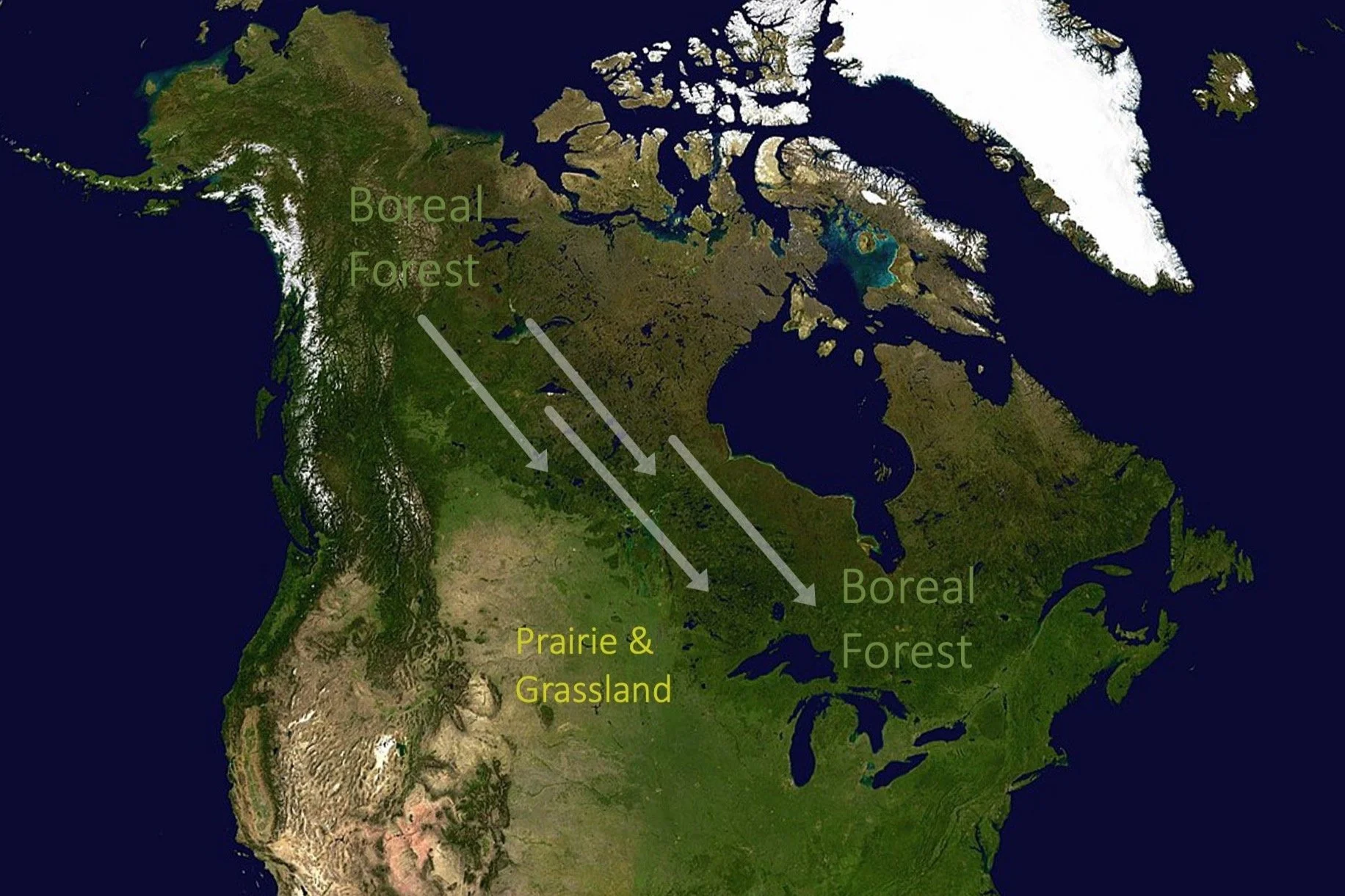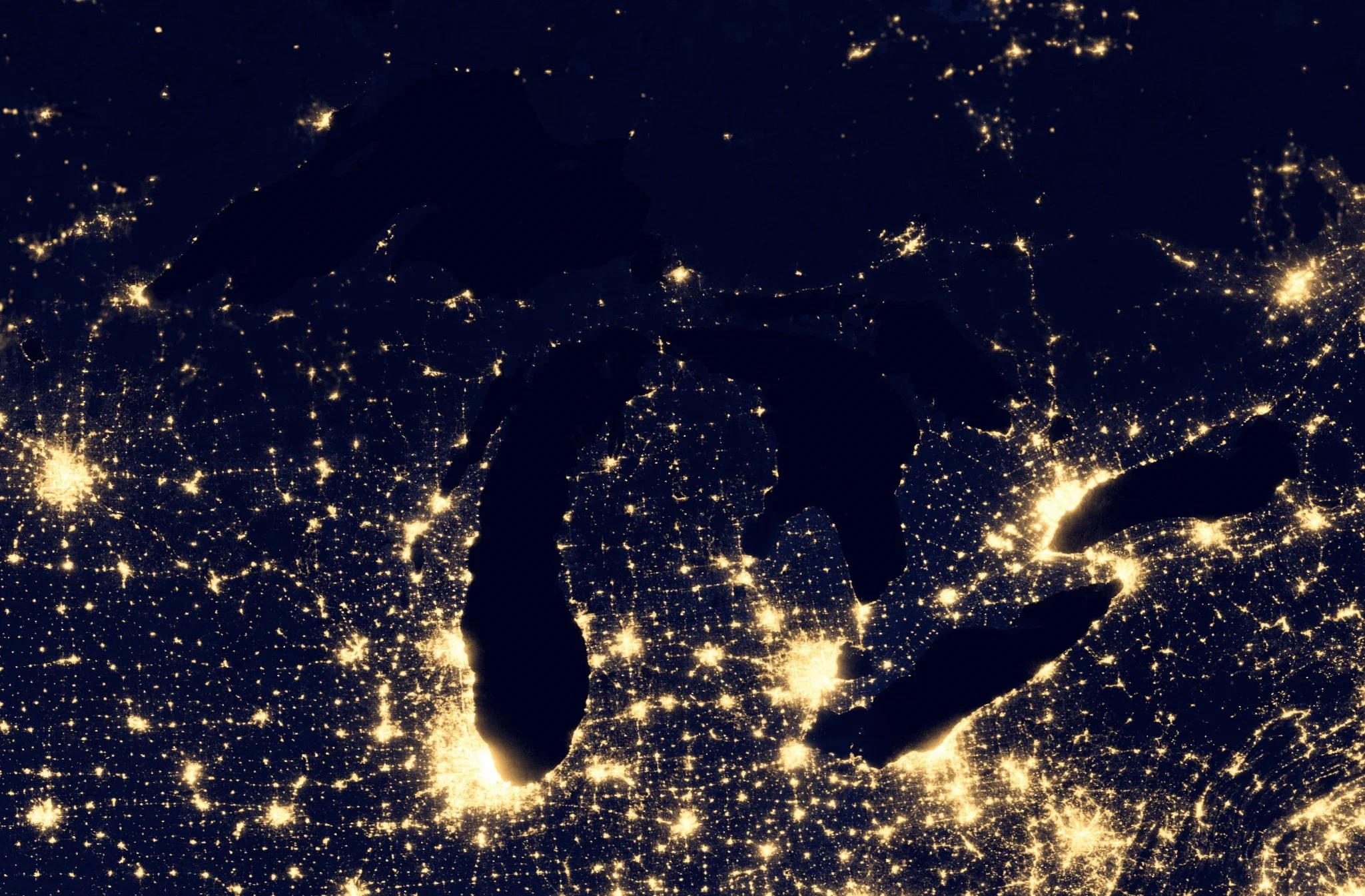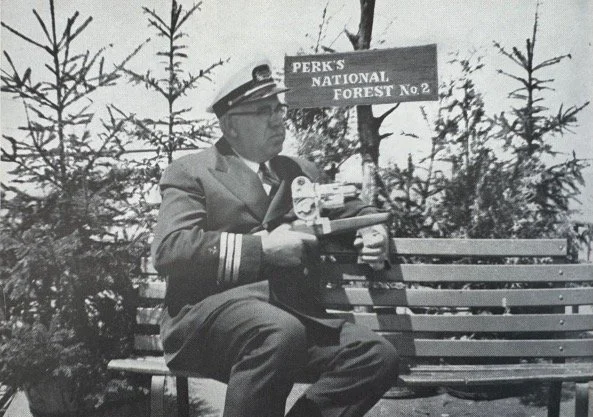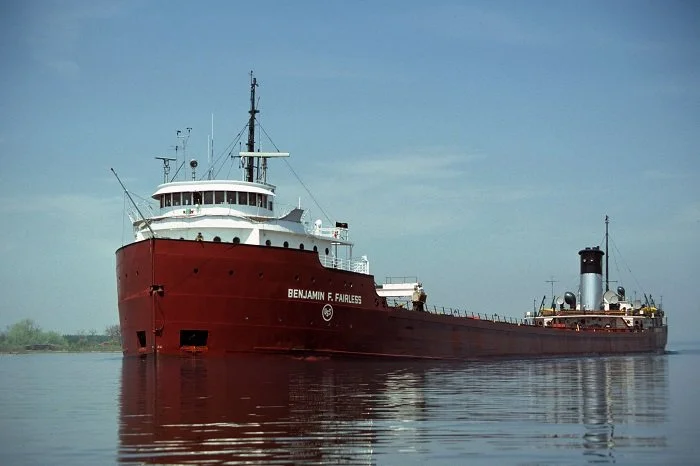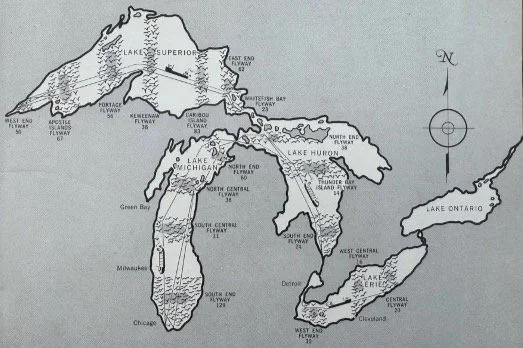Now Accepting Tax Deductible Donations
Help bring the story of Captain Perkins and Great Lakes bird migration to life!

PROJECT UPDATE
Chasing Bird Migration Through Time
The ghost of a Great Lakes ore ship captain helps protect a natural phenomenon under threat.
Image: Bjornberg Photography
September 1962.
Perk opens the door to the thick scent of cold wet iron. He squints against the deck lights, the freighter’s speed revealed by minuscule rainbows reflecting in fog moving past the wheelhouse. Droplets form on his heavy peacoat, the officer jacket of the Pittsburgh Steamship Division. He pauses to sip coffee from the lip of a mug, lest he spill in his eagerness to witness what he’d predicted would happen this night.
“Captain Perk, watch your step!” the lookout yells. “Many are still alive.”
WEATHERING THE STORM. Migratory birds crossing the North American Great Lakes often seek refuge and rest aboard ships, especially during inclement weather. Painting: Neil Davison
RECORDING MIGRATORY BIRDS. During both spring and fall, the coastal areas of the North American Great Lakes host massive migratory bird movements and provide essential stopover habitat for the travelers to rest and refuel. Image: Derek Montgomery / MPR.
September 2010.
I met Captain J. P. “Perk” Perkins in a photo near the center crease of an old magazine. A week had passed since I witnessed what my colleagues at first dubbed a product of a vivid imagination. At a high point along Lake Superior’s northern coast, a predawn cloudburst of songbirds suddenly appeared in the sky above and around me. Thousands of warblers, thrushes, grosbeaks, vireos, and other birds moved en masse from the direction of the lake. Shortly after the sun cleared Superior’s horizon, they vanished.
Sometime later, a frayed magazine landed on my desk with the note read this marking a page. By then, the captain had been gone for 20 years.
- Anna Peterson, NatureWerks, excerpts from essays developed with funding from the Minnesota State Arts Board
The fog had changed to a misty drizzle. When I aimed the searchlight upward, the beam revealed heavy flights of passing birds. Others fluttered around the ship’s lights by the dozen. At times there were so many on the bridge deck that the lookout had to be careful not to step on them.
Captain J. P. Perkins, U.S. Steel Corporation, Audubon Magazine 1964
Challenge: A migration phenomenon under threat
Every fall 90% of the biodiversity in North America’s boreal forest takes to the sky in one of the world’s largest natural phenomena — the boreal bird migration. But in the past 50 years, North America has lost 2.9 billion birds, one-third of the avian population. Most of those lost are migratory birds. One-third of the 4 billion birds that migrate south in the fall will not survive to return in the spring. Human caused threats throughout this journey compound and accellerate already high levels of natural mortality.
MIGRATING TREE SWALLOWS. Migratory birds tend to concentrate in large numbers along any number of U.S. coastlines including the N. American Great Lakes. Image: William Leaman / Alamy
During fall migration, billions of birds travel on a movement trajectory that guides them towards the North American Great Lakes region. Ten percent of the U.S. population (over thirty million people) and thirty percent of the Canadian population (eleven million people) live within the watersheds of the Great Lakes. This includes the cities and metropolitan areas of Duluth, Green Bay, Milwaukee, Chicago, Detroit, Windsor, Toledo, Cleveland, Buffalo, and Toronto. These same coastal areas host disproportionally large concentrations of birds during migration. Impacts from the most dangerous human-centric threats to birds — including habitat loss, predators, pesticides, and collisions with manmade structures such as buildings, communication towers, wind turbines, and power lines — are intensified in these populated coastal regions.
A CONTINENTAL PHENOMENON. Every fall, up to five billion birds migrate out of N. America’s boreal forest to areas as far south as South America. Avoiding the prairies and guided by NW winds, many migrate to and through the Great Lakes region.
ATTRACTED TO COASTAL GLOW. Nocturnally migrating birds are drawn to artificial light and disproportionately concentrate their movements and stops within Great Lakes coastal cities. Within these ‘light halos,’ mortality caused by collisions with structures and predation by house cats is intensified.
An Ore Ship Captain and His Onboard Forest
SHELTERING IN A FREIGHTER’S FOREST. In 1958, after years of photographing the migratory birds that landed on his ships to rest during migration, Captain J.P. Perkins (pictured) created a mini-forest of potted trees for the feathered castaways. Image: J.P. Perkins / U.S. Steel.
From 1928 to 1972, Captain J. P. “Perk” Perkins sailed the Great Lakes onboard freighters that carried ore and other cargo between Lake Superior and Lake Erie. Perk had a unique passion for birds. For the majority of his life as a mariner, Perk recorded the migratory birds that sought shelter on his ships. He placed bird seed, fresh water, and a cobbled assortment of potted trees on his freighter's deck to attract and better film the birds, an assemblage the crew named Perk’s National Forest.
GREAT LAKES IRON ISLAND. From hawks to hummingbirds, Captain Perkins recorded over 150 species of migratory birds using his freighters as overwater refuges. The 622 foot Benjamin F. Fairless was one of several ships that hosted Perk’s National Forest. Image: Roger LeLievre / Shipwater News.
After decades of sailing the Great Lakes, Captain Perkins could predict when his freighter would enter any one of 17 different flight corridors that hosted massive numbers of migrating birds. He documented and told stories of his bird migration observations through a film production he called Birds Ahoy. He also published a hand-drawn corridor map in Audubon Magazine to educate the public and scientific community about these over water movement corridors.
Mapping Migration Routes
A CAPTAIN AND A SCIENTIST. Perk was skilled at identifying birds and drew this map based on where his freighters would cross into their migratory flight paths. Image: J.P. Perkins / Audubon Magazine
In my long career, I have worked on hundreds of research projects. The story of Captain Perkins is one of the most personally compelling. Not only is it an early and valuable example of citizen science, but the captain’s story itself is captivating. NatureWerks threads migration science and his legacy with grace.
Dr. Douglas Johnson, Research Statistician (Emeritus), University of Minnesota and US Geological Survey.
Captain Perkins Project
Strategy
This project seeks to tell Captain Perkins’ story to foster awareness of, interest in, and protection for the bird migration phenomenon he sought to understand and the story that he worked to tell.
Outcomes
Historical ecology. Preserve, archive, and restore Captain Perkins voluminous records, including avian data, journal entries, artwork, photos, and film. Interview people who knew the captain and his story.
Human interest. Bring the story of Great Lakes bird migration to life through art, media, science, and creative writing. Build community campaigns to learn about, cultivate pride in, and protect this beautiful phenomenon under threat throughout the Great Lakes region.
Traveling Multimedia. Empower people to see the beauty and resilience of birds migrating through their home towns through a traveling art, science, history, and human interest exhibit coupled with regional events in cities and towns throughout the Great Lakes region.
Mapping Migration. Support science to map important bird movement areas both on and offshore in habitat and airspace. Compare new data with maps Captain Perkins drafted 60 years ago. This includes emerging techniques being advanced by ornithologists and citizen science observations by regional bird lovers. Use this information to inform conservation and development.

